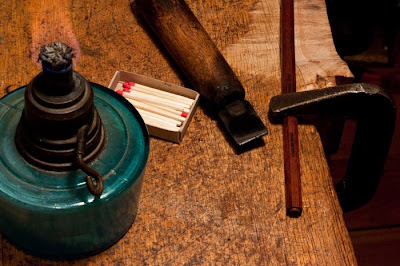Now the head is brought down to its anticipated height and the tip-plate with its ebony liner is glued in place. The height of the head strongly influences the way the stick articulates because it acts like a tiny lever that facilitates pulling up the hair away from the stick. Even a difference in height of one tenth of a millimeter will make a difference. In a sense the head depowers the stick and allows the hair to be at playing height without being under too much tension. The stick itself is just as strong but that strength is kept in reserve. We will go into this in more detail when the stick is being adjusted. Historically, earlier bows had a higher head and this was reduced by Voirin and his school in the latter 19th century by about one millimeter.
Bowmakers typically work directly with raw materials, working with logs or boards of wood and sheets of silver or rough slices of mother of pearl. But traditionally the tip plate was prepared in its simple rectangular form by another artisan or a bowmaker who specialized and could purchase a special saw and cut large numbers. In France in the 1980’s, virtually all tip plates were prepared by Roger Gerome, a genial old Mirecourt bowmaker. The photo on the left shows him when he was younger. I remember visiting him and seeing his fine jigsaw for cutting ivory. He joked that ever since he gave his chickens ivory dust they laid white eggs.

Until the 1980’s all fine bows had an ivory tip-plate with the exception of a few with gold or silver tip-plates. But then bow-makers became aware of the plight of Africa’s elephants and the export of ivory was controlled strictly by CITES, the international organization regulating the trade in endangered species. After experimenting with bone, which is less than ideal, bowmakers discovered the availability of Mammoth ivory. In the permafrost of Siberia and Alaska, the local peoples keep an eye on the constantly changing riverbanks as they travel by boat. From time to time the tusks and other remains of a Mammoth will be exposed after lying frozen for over 10,000 years. These tusks are legally collected and sold, offering bowmakers an alternative. I have used Mammoth ivory for about 25 years. Sometimes while filing the material I smell its toasty odor and I’m astounded to be working with a natural material that is so old. The tips are cut out for me by an ivory carver who makes use of his scraps. They come oversized so I cut them down to size and bend them.

The tip plate includes a layer of ebony that varies in thickness according to the head’s style or period. The tip-plate is glued on with a mixture of two kinds of hot glue in equal proportions, ‘colle de nerf’ and ‘colle de os’. One is made from sinews and the other from bones. This glue has been used in woodworking since the time of the ancient Egyptians and has always been used in violinmaking. In my opinion it will last longer than any synthetic glues.

At this point the head will stay in its roughed out state while we plane the stick down further.






































